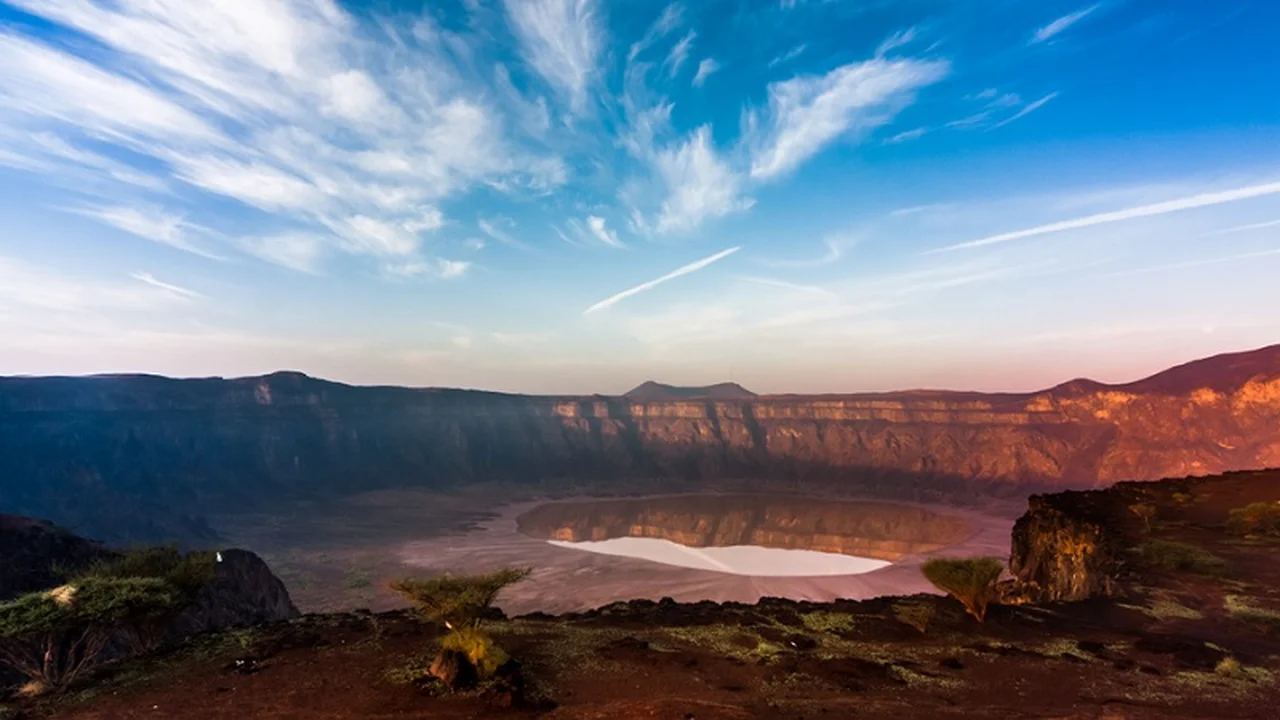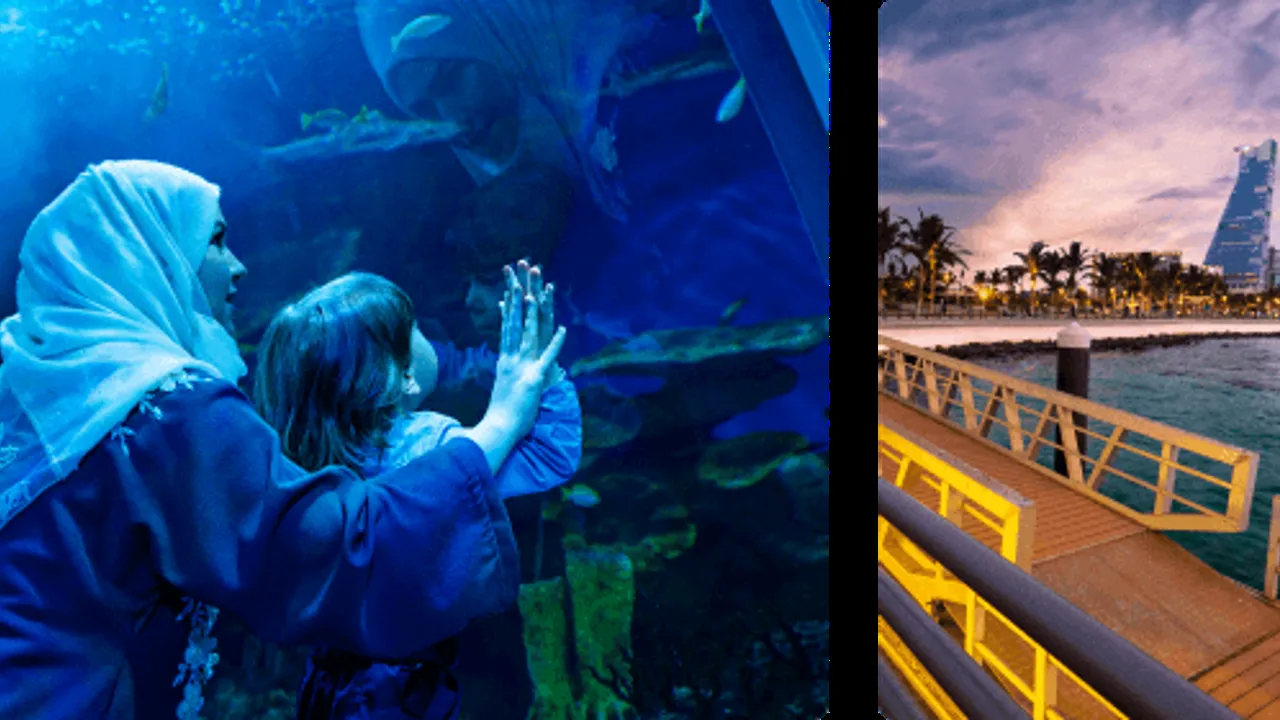
Imagine standing on the rim of a colossal crater, the wind whipping around you, the silence broken only by the occasional call of a desert bird. Below, a vast expanse of white salt flats stretches out, shimmering under the relentless Saudi Arabian sun. This is Al Wahbah Crater, a geological marvel that leaves visitors speechless. It’s not just a hole in the ground; it’s a window into the Earth’s fiery past and a testament to the raw, untamed beauty of the Arabian desert.
Unveiling the Mystery of Al Wahbah Crater Formation Exploring the Volcanic Origins
For years, locals believed Al Wahbah Crater was formed by a meteorite impact. The sheer size and dramatic appearance of the crater certainly lend themselves to such a theory. However, scientists have since debunked this myth, revealing the true, more complex story of its creation. The crater is, in fact, a maar crater, formed by a phreatomagmatic eruption. This occurs when molten basaltic magma interacts violently with groundwater, causing a massive steam explosion that blasts a large depression into the Earth's surface. Think of it as a giant pressure cooker letting off steam – with a lot more force and drama!
The specific sequence of events goes something like this: Deep beneath the surface, magma, rich in iron and magnesium, began to rise. As it encountered groundwater, the water flashed into steam, creating immense pressure. This pressure eventually exceeded the strength of the overlying rock, resulting in a cataclysmic explosion. The explosion ejected ash, rock fragments, and steam high into the atmosphere, leaving behind a vast, bowl-shaped crater. Over time, the crater floor has become covered in a layer of white sodium phosphate crystals, adding to the surreal and otherworldly landscape.
Planning Your Desert Adventure to Al Wahbah Crater Essential Travel Tips
Visiting Al Wahbah Crater is an adventure, and like any adventure, it requires careful planning. The crater is located in a remote area, far from major cities and tourist infrastructure. This isolation is part of its charm, but it also means you need to be prepared.
Getting There: The most common way to reach Al Wahbah Crater is by car. You'll need a 4x4 vehicle, as the roads leading to the crater are unpaved and can be challenging, especially after rain. From Jeddah, the drive takes approximately 4-6 hours. From Riyadh, it's a longer journey, around 8-10 hours. Consider breaking up the journey with an overnight stay in a nearby town like Taif.
When to Visit: The best time to visit Al Wahbah Crater is during the cooler months, from October to April. During the summer, temperatures can soar to extreme levels, making hiking and outdoor activities unbearable. Even during the cooler months, be prepared for hot days and cool nights.
What to Bring: Essential items for your trip include plenty of water, sunscreen, a hat, sunglasses, comfortable hiking shoes, and a first-aid kit. A GPS device or offline maps are also highly recommended, as cell phone service can be unreliable in the area. Consider bringing a camera to capture the stunning scenery.
Accommodation: There are no hotels or resorts directly at Al Wahbah Crater. The nearest accommodation options are in nearby towns like Taif and Al Qassim. Camping is possible, but it's essential to be self-sufficient and prepared for desert conditions.
Hiking Down into the Heart of Al Wahbah Crater A Challenging but Rewarding Experience
One of the most rewarding experiences at Al Wahbah Crater is hiking down to the crater floor. The trail is steep and rocky, but the views along the way are breathtaking. The descent takes approximately 1-2 hours, depending on your fitness level. Be sure to wear sturdy shoes and take plenty of water.
As you descend, you'll notice the changing landscape. The volcanic rock formations become more prominent, and the white salt flats stretch out before you. The silence is almost deafening, broken only by the sound of your own footsteps. Reaching the crater floor is an accomplishment in itself. Take some time to explore the salt flats, marvel at the towering crater walls, and soak in the surreal atmosphere.
The ascent back up is even more challenging than the descent. Take your time, pace yourself, and remember to hydrate regularly. The sense of accomplishment you'll feel upon reaching the rim again is well worth the effort.
Capturing the Beauty of Al Wahbah Crater Photography Tips for Stunning Desert Landscapes
Al Wahbah Crater is a photographer's dream. The dramatic landscape, the contrasting colors, and the vastness of the desert provide endless opportunities for stunning photographs. Here are a few tips to help you capture the beauty of this natural wonder:
Golden Hour: The best time to photograph Al Wahbah Crater is during the golden hour, the hour after sunrise and the hour before sunset. The soft, warm light of the golden hour creates a magical atmosphere and enhances the colors of the landscape.
Wide-Angle Lens: A wide-angle lens is essential for capturing the vastness of the crater and the surrounding desert. It allows you to fit more of the scene into your frame and create a sense of scale.
Composition: Pay attention to composition. Use leading lines, such as the crater rim or the trail leading down to the crater floor, to draw the viewer's eye into the scene. Experiment with different angles and perspectives to find the most compelling composition.
Filters: A polarizing filter can help reduce glare and enhance the colors of the sky and the landscape. A neutral density filter can be used to reduce the amount of light entering the lens, allowing you to use longer shutter speeds to create motion blur or smooth out water.
Post-Processing: Don't be afraid to edit your photos in post-processing. Adjust the exposure, contrast, and colors to bring out the best in your images. Use tools like Adobe Lightroom or Photoshop to remove distractions, sharpen details, and create a polished final product.
Exploring Nearby Attractions Enhancing Your Al Wahbah Crater Experience
While Al Wahbah Crater is the main attraction in the area, there are other nearby sites worth exploring. Combining your visit to the crater with a trip to these other attractions can enhance your overall experience and give you a deeper appreciation for the region's natural and cultural heritage.
Taif: The city of Taif, located about 200 kilometers from Al Wahbah Crater, is a popular summer resort known for its cool climate, lush gardens, and historical sites. Visit the Al Shareef Museum to learn about the history of the region, explore the Shubra Palace, a former royal residence, or take a cable car ride up to the Al Hada Mountains for panoramic views.
Makkah: As the holiest city in Islam, Makkah is a significant religious site for Muslims around the world. While non-Muslims are not permitted to enter the city, you can still admire the Grand Mosque and the Kaaba from a distance. Makkah is located about 300 kilometers from Al Wahbah Crater.
Edge of the World (Jebel Fihrayn): Located near Riyadh, the Edge of the World is a dramatic escarpment offering breathtaking views of the surrounding desert. It's a popular spot for hiking, camping, and photography. The Edge of the World is about 500 kilometers from Al Wahbah Crater.
Gear Up For Adventure Product Recommendations for Exploring Al Wahbah Crater
A successful trip to Al Wahbah Crater requires the right gear. Here are some product recommendations to help you prepare for your desert adventure:
Water Filter Bottle: Sawyer Products Squeeze Water Filter System
Use Case: Staying hydrated is crucial in the desert. This lightweight and portable water filter bottle allows you to filter water from any source, ensuring you have access to safe drinking water throughout your hike. It's ideal for refilling from streams or even questionable water sources, providing peace of mind in a remote location. Product Details: This filter removes 99.99999% of bacteria and protozoa. It's compact, durable, and filters up to 1 million gallons of water. Priced around $30, it's a worthwhile investment for any outdoor adventure.
Hiking Boots: Salomon X Ultra 4 GTX Hiking Shoes
Use Case: The trail to the bottom of Al Wahbah Crater is rocky and uneven. Sturdy hiking boots are essential for providing ankle support and preventing injuries. These boots are waterproof, breathable, and offer excellent traction on various terrains. Product Details: These boots feature a Gore-Tex membrane for waterproofing, a Contagrip outsole for superior grip, and a cushioned midsole for all-day comfort. They are available in various sizes and colors, priced around $150.
Sunscreen: EltaMD UV Clear Broad-Spectrum SPF 46
Use Case: The Saudi Arabian sun is intense. Protecting your skin from harmful UV rays is crucial. This sunscreen is lightweight, oil-free, and provides broad-spectrum protection against both UVA and UVB rays. Product Details: This sunscreen contains zinc oxide and octinoxate for effective sun protection. It's also formulated with niacinamide to help calm and protect the skin. Priced around $35, it's a must-have for any outdoor adventure.
Portable Power Bank: Anker PowerCore 20100 Portable Charger
Use Case: Cell phone service can be unreliable in the area, but you'll still want to have a charged phone for taking photos and in case of emergencies. This power bank provides multiple charges for your phone and other devices. Product Details: This power bank has a capacity of 20100mAh, allowing you to charge your phone multiple times. It features fast charging technology and comes with a micro USB cable. Priced around $50, it's a reliable power source for your trip.
Headlamp: Black Diamond Spot 350 Headlamp
Use Case: If you're planning on hiking down to the crater floor in the early morning or late afternoon, a headlamp is essential for navigating the trail in low light conditions. This headlamp is lightweight, bright, and features multiple lighting modes. Product Details: This headlamp has a maximum output of 350 lumens and a beam distance of up to 80 meters. It's waterproof and features a comfortable headband. Priced around $40, it's a reliable lighting solution for your adventure.
Choosing the Right Gear A Detailed Comparison of Top Brands
When it comes to outdoor gear, there are many brands to choose from. Here's a comparison of some top brands to help you make informed decisions:
Water Filter Bottle: Sawyer vs. LifeStraw
Both Sawyer and LifeStraw are popular brands for water filter bottles. Sawyer filters remove more contaminants and have a longer lifespan, filtering up to 1 million gallons compared to LifeStraw's 1000 gallons. However, LifeStraw bottles are often more compact and easier to use. Ultimately, the best choice depends on your specific needs and preferences.
Hiking Boots: Salomon vs. Merrell
Salomon and Merrell are both well-known for their high-quality hiking boots. Salomon boots are known for their superior grip and stability, making them ideal for challenging terrains. Merrell boots are often more comfortable and offer a wider fit, making them suitable for longer hikes. Consider the type of terrain you'll be hiking on and your personal comfort preferences when choosing between these brands.
Sunscreen: EltaMD vs. Neutrogena
EltaMD and Neutrogena are both dermatologist-recommended brands for sunscreen. EltaMD sunscreens are known for their gentle formulas and broad-spectrum protection. Neutrogena sunscreens are often more affordable and widely available. If you have sensitive skin, EltaMD is a good choice. If you're looking for a budget-friendly option, Neutrogena is a reliable alternative.
Portable Power Bank: Anker vs. Mophie
Anker and Mophie are leading brands for portable power banks. Anker power banks are known for their high capacity and fast charging technology. Mophie power banks are often more stylish and feature integrated charging cables. Consider your charging needs and aesthetic preferences when choosing between these brands.
Headlamp: Black Diamond vs. Petzl
Black Diamond and Petzl are both reputable brands for headlamps. Black Diamond headlamps are known for their brightness and durability. Petzl headlamps are often more lightweight and feature advanced lighting modes. Consider the intensity of light you need and the weight of the headlamp when making your decision.
Understanding Pricing Factors Decoding the Cost of Your Desert Adventure
The cost of a trip to Al Wahbah Crater can vary depending on several factors, including transportation, accommodation, gear, and activities. Here's a breakdown of the key pricing factors:
Transportation: Renting a 4x4 vehicle is the most significant transportation expense. Rental prices can range from $50 to $150 per day, depending on the type of vehicle and the rental company. Fuel costs will also add to the overall expense.
Accommodation: Hotels in nearby towns like Taif and Al Qassim can range from $50 to $200 per night, depending on the level of luxury. Camping is a more budget-friendly option, but it requires you to bring your own equipment.
Gear: Investing in quality outdoor gear can add to the upfront cost of your trip. Hiking boots, sunscreen, a water filter bottle, and a headlamp are essential items. The total cost of gear can range from $200 to $500, depending on the brands you choose.
Activities: Hiking down to the crater floor is free, but you may want to hire a local guide for a more informative experience. Guided tours can range from $50 to $100 per person.
Food and Drinks: Food and drinks can be purchased in nearby towns. Budget approximately $20 to $50 per day for meals.
Overall, a trip to Al Wahbah Crater can cost anywhere from $500 to $1500 per person, depending on your travel style and preferences. Planning your budget in advance will help you make the most of your adventure.
The Future of Al Wahbah Crater Sustainable Tourism and Conservation Efforts
As Al Wahbah Crater becomes an increasingly popular tourist destination, it's essential to prioritize sustainable tourism practices and conservation efforts to protect this natural wonder for future generations. This includes promoting responsible waste management, minimizing environmental impact, and supporting local communities.
Educational programs and awareness campaigns can help visitors understand the importance of preserving the crater's unique ecosystem. Encouraging eco-friendly practices, such as using reusable water bottles and avoiding single-use plastics, can significantly reduce the amount of waste generated at the site.
Collaboration between government agencies, local communities, and tourism operators is crucial for implementing effective conservation strategies. This includes establishing protected areas, regulating tourism activities, and investing in infrastructure that supports sustainable tourism.
By embracing responsible tourism practices and supporting conservation efforts, we can ensure that Al Wahbah Crater remains a captivating destination for years to come, allowing future generations to experience the awe-inspiring beauty of this volcanic wonder in the desert.
:max_bytes(150000):strip_icc()/277019-baked-pork-chops-with-cream-of-mushroom-soup-DDMFS-beauty-4x3-BG-7505-5762b731cf30447d9cbbbbbf387beafa.jpg)





